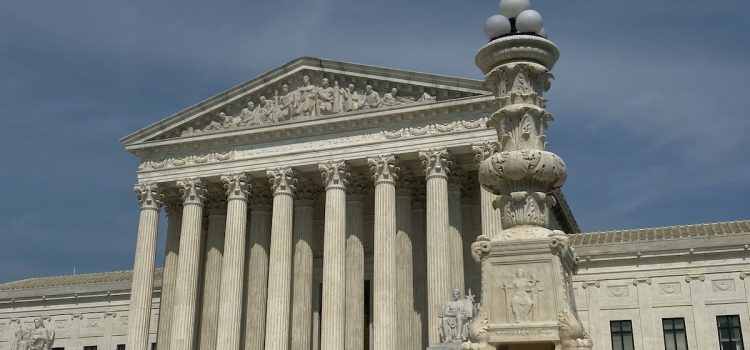

This article is an excerpt from the Shortform guide to "The Daily". Shortform has the world's best summaries and analyses of books, podcasts, and more.
Like this article? Sign up for a free trial here.
How should the Second Amendment be interpreted in the 21st century? Should historical precedent inform legislation today?
The Daily podcast took on the controversial topic of gun rights. Supreme Court justices and legal experts discussed how the Second Amendment should be interpreted today. Host Sabrina Tavernise led a deep dive into a momentous case holding significant implications for America’s gun rights landscape.
Continue reading for a summary of the episode—along with context, alternative perspectives, and recommendations for related reading.
Gun Rights and the Supreme Court
Dissecting a complex hearing centered on gun rights, Supreme Court Justices John Roberts, Clarence Thomas, and Ketanji Brown Jackson joined legal experts Adam Liptak and Elizabeth Prelogar and host Sabrina Tavernise on The Daily. They focused on the interpretation of the Second Amendment in modern times. The recent Bruen decision added complexity to the matter, raising questions about how historical precedent should inform current firearms legislation.
With major implications for gun rights across the country, the Supreme Court is currently considering a case involving gun ownership by individuals with domestic violence restraining orders.
In the episode, Sabrina Tavernise focused on a Supreme Court hearing that tackles the legality of banning individuals with domestic violence restraining orders from owning guns. The crux of the case hinges on how the Second Amendment is interpreted after the Bruen decision. This earlier ruling stipulated that historical precedents should be used to evaluate modern gun control regulations.
The Role of Historical Precedents in Modern Gun Laws
The Supreme Court justices revealed differing opinions. Justice Clarence Thomas raised concerns about using civil court rulings in domestic violence cases to prevent someone from owning a gun before they’ve actually committed a crime. He believes this could unfairly restrict their Second Amendment rights.
In contrast, Justice Ketanji Brown Jackson highlighted the difficulty of applying historical precedents to modern legal issues related to guns. She argued that circumstances and societal perspectives have changed significantly since the Second Amendment was written, making it challenging to directly apply historical interpretations to contemporary situations. In the Rahimi case, she argued that this historical approach might create a disconnect between past precedents and present-day legal challenges.
Adding further weight to the case’s seriousness, Chief Justice John Roberts made a significant move by directly describing the defendant in the case as a potential threat. This unusual step highlights the gravity of the situation and the potential consequences of the court’s decision.
The Supreme Court’s divided opinions hint at a potential change in how they approach cases. Legal expert Adam Liptak identified three main groups among the justices:
- Centrist Republican appointees: These justices might take a more moderate approach.
- Liberal justices: These justices generally favor interpretations based on modern principles and values.
- Right-leaning justices such as Thomas and Alito: These justices favor basing their decisions on historical context and the original meaning of the Constitution.
Some experts speculate that the Court might move toward a more principle-based approach, which aligns more with liberal theories. This could significantly impact future gun laws and how the Second Amendment is interpreted.
Recent Jurisprudence and Historical Developments
The discussion highlighted that the Supreme Court’s recognition of individual gun ownership rights is a relatively recent development, starting with a landmark decision in 2008. Since then, the Court hasn’t tackled major Second Amendment issues until introducing a new legal test in 2022. The Rahimi case, expected to be a significant turning point, is therefore crucial in determining the limits of these gun rights.
This new focus on the Second Amendment stands in stark contrast to the Court’s long history of dealing with First Amendment cases, as evidenced by several such cases being addressed in the current term.
Context
The Second Amendment of the US Constitution, stating “the right of the people to keep and bear Arms, shall not be infringed,” has sparked centuries of debate and legal wrangling. This amendment’s meaning and limitations regarding gun ownership remain central to a crucial American conversation.
In 2008, the landmark Supreme Court case District of Columbia v. Heller established an individual’s right to own firearms for self-defense at home. Since then, various cases—including those involving domestic violence and gun possession—have tested and challenged interpretations of the Second Amendment.
Recent events such as the Bruen decision highlight the complex role of historical context in shaping modern gun rights decisions. It emphasizes the importance of understanding past precedents when evaluating contemporary regulations. Also, debates such as the Rahimi case explore the legality of prohibiting gun ownership for individuals under domestic violence restraining orders, raising questions about balancing rights and public safety.
These discussions delve into broader themes, including the following:
- Constitutional law interpretation: How do different justices approach the Second Amendment and its applications?
- Gun control vs. gun rights: Can these be balanced? If so, how?
- Domestic violence legislation: How should it interact with gun ownership rights?
- Shifting legal perspectives: Could interpretations of gun rights become more liberal or principle-based?
In the future, key aspects to watch include the following:
- Court rulings’ impact: How will future decisions affect existing gun laws and interpretations of the Second Amendment?
- Rahimi case implications: What consequences could it have for domestic violence policies and broader gun ownership protections?
- Liberal constitutional theory approach: Will it play a larger role in interpreting gun rights?
Ongoing debates about the Second Amendment continue to shape the complex landscape of individual gun ownership versus public safety concerns in America. Historical context, recent court decisions, and evolving legal perspectives all influence this crucial conversation.
More Perspectives
The upcoming Supreme Court case involving gun possession and domestic violence has sparked discussions about its potential impact, but caution is needed to avoid oversimplification and speculation. Here’s why:
- Limited scope: We shouldn’t assume this case will fundamentally reshape gun laws. The Court’s ruling might be specific to the individual circumstances, so generalizing its impact on broader gun rights could be misleading.
- Balance is key: While historical context matters in interpreting the Second Amendment, clinging to outdated standards without considering modern contexts such as domestic violence could hinder effective regulations. Striking a balance between individual rights and public safety is crucial.
- Beyond ideology: The Justices’ diverse opinions during oral arguments don’t automatically signal a future judicial shift. Many factors beyond their personal views, including legal precedent and case specifics, influence rulings. Excitement about a potential “pivot” toward liberal interpretations should be tempered with caution.
Here are a few things to keep in mind:
- Multiple perspectives: A thorough analysis demands considering various viewpoints and the complexities surrounding gun rights and regulations.
- No sweeping assumptions: Valid concerns exist about historical precedents and their modern application, particularly in domestic violence scenarios. But, making broad assumptions about future judicial approaches or widespread changes in gun laws based solely on oral arguments is unwise.
Ultimately, a nuanced understanding of this case requires acknowledging its limitations, recognizing the evolving landscape of gun policy, and avoiding hasty conclusions based on limited information.
Related Summaries
US supreme court hears case on reinstating gun possession
The US Supreme Court heard oral arguments in a case that could restore gun possession rights to individuals under domestic violence restraining orders. The case has significant implications for families and survivors of domestic abuse.
How Should Courts Evaluate Gun Regulations After Bruen? – Reason.com
The N.Y. State Rifle & Pistol Association v. Bruen opinions have sparked debates about gun regulations. Based on Justice Thomas’s majority opinion, the right to keep and bear arms includes self-defense both at home and outside.
Why You Should Understand Gun Laws
How much do you know about US gun laws? Would you recognize an illegal gun? Do you know which types of AR-15s have to be registered and which don’t? If not, here’s a primer on what you should know about gun laws and why.
Why Banning AR15s Isn’t as Simple as It Sounds
Is it even possible to ban AR-15s in America, as some advocate in response to mass shootings using the weapons? In this article, we’ll examine four key challenges that any such ban would need to address in order to succeed.

———End of Preview———
Like what you just read? Read the rest of the world's best guides to The Daily" at Shortform.
Here's what you'll find in our full The Daily episode summaries:
- Key insights from the daily podcast from the New York Times
- Key topics that came up during interviews with the paper’s journalists
- Some of the main news stories from the day that you need to know






